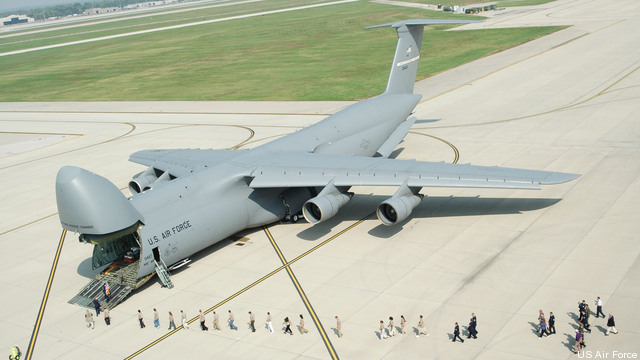EXCLUSIVE: HASC Try To Protect Air Guard May Mess Up C-5 Plans, Association Warns
Posted on

WASHINGTON: Both chambers of Congress have resoundingly rejected the administration’s proposed cuts to the Air National Guard and Air Force Reserve – but the language that the House passed is so sweeping that it may inadvertently block the modernization of the very Guard and Reserve forces it was written to protect, according to Hill sources and the powerful National Guard Association of the US.
By banning the retirement of any Air Force aircraft, without exception, the House version of the National Defense Authorization Act for 2013 conflicts with long-standing plans to replace the Guard and Reserve’s aging Lockheed Martin C-5A Galaxy cargo planes with a mix of the modernized C-5M version and newly built Boeing C-17 Globemasters. By contrast, the Senate Armed Services Committee version explicitly carves out an exception that allows the retirement of the C-5As if and only if they are replaced with newer aircraft. The Air Force’s budget proposal would retire five Air Force Reserve C-5As in fiscal year 2013 alone and a total of 27 Reserve and Guard C-5As by 2017, replacing them with 8 C-5Ms and 8 C-17s. That’s a trade the Guard and Reserve are glad to make, if the House will let them.
“I’ve never had a problem with retiring anything as long as they modernize the unit,” said retired Maj. Gen. Gus Hargett, the National Guard Association president, in a Thursday afternoon phone call to Breaking Defense. Even though the old C-5As will not be replaced with new planes one-for-one, he said, it’s a net gain for the Guard. “They’ll get less airplanes and they’ll get less people, but at least it’s a modernized unit,” Hargett said. “When you’re spending this much money on modern aircraft, you’re not going to have as many of them, and we understand that.”
So does the House language as written – unlike the Senate’s – potentially throw a wrench into Guard and Reserve modernization?
“I think it probably does,” Hargett said. “It’s something that will be worked out in the language between the House and the Senate.”
Hargett expects to discuss the C-5 retirement issue at next week’s meeting in Nebraska of the nation’s adjutants-general – the 54 top officers who command the Guard in each state, territory, and the District of Columbia – and he’ll carry their consensus recommendation back to Washington. While Hargett carefully did not predict what that recommendation would be, he emphasized that “for me, personally, modernization is what it’s all about.” In the long run, Hargett said, it’s replacing old aircraft with new ones, not holding onto the old, that is in the best institutional interest of the Guard. “I just don’t want to see the Guard stuck with an aircraft that every year they’re going to try to do away with,” he said. “If you don’t have modern aircraft, eventually they’re going to do away with you.”
House Armed Services Committee spokesman Claude Chafin acknowledged that the current language may well have unintended consequences: “There are going to be cascading ramifications” of the House’s broad ban on retiring aircraft, he told Breaking Defense, and that possibility is something the committee is still working through.
“Both House and Senate provisions are very broad,” said one Hill source. “I would expect them to narrow both provisions to avoid ‘collateral damage’ on non-controversial changes. I also think they will have to narrow them because they would be massive unfunded mandates if the appropriators don’t cover the cost.”
Subscribe to our newsletter
Promotions, new products and sales. Directly to your inbox.
